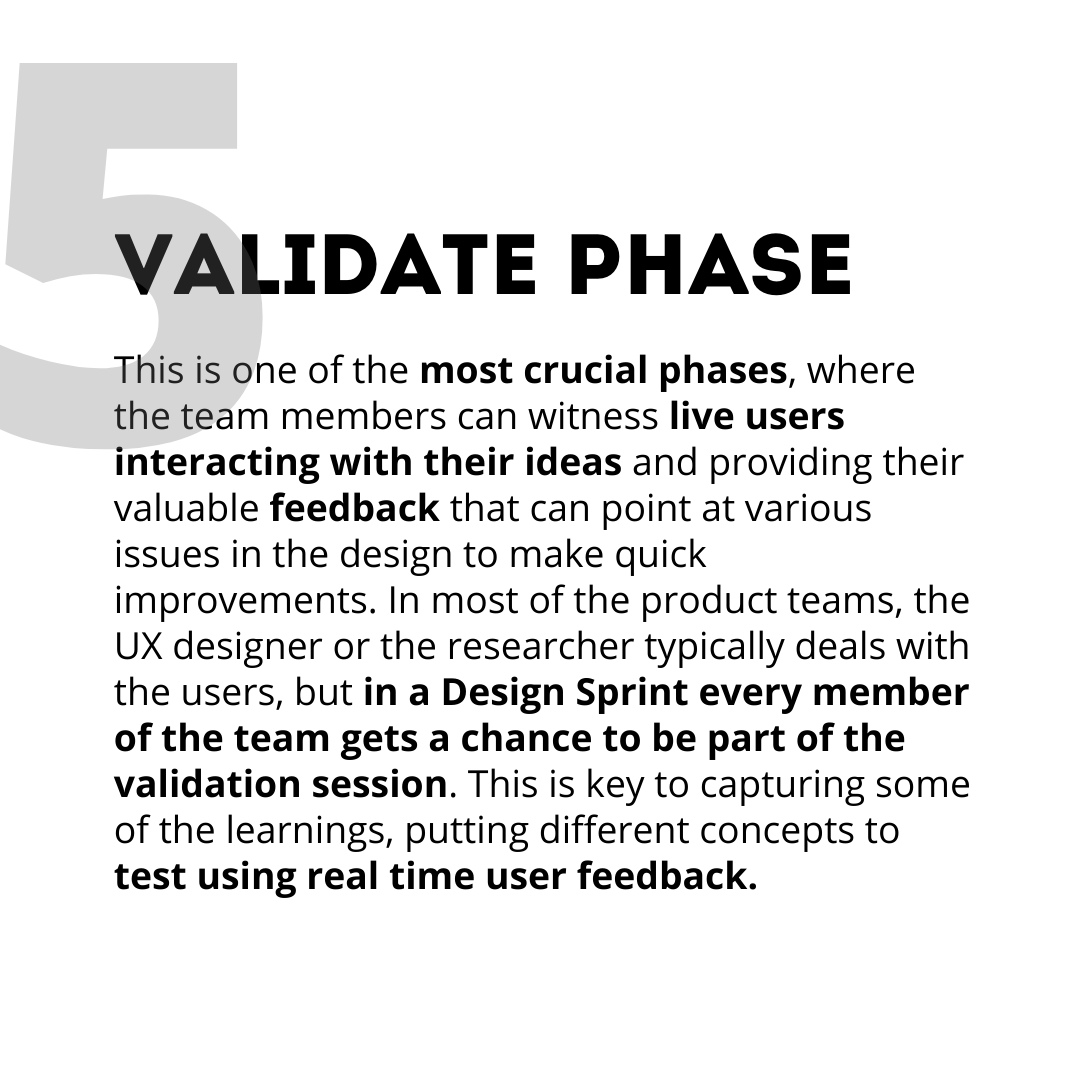5 Phases of a Design Sprint
“By asking people for their input early in the process, you help them feel invested in the outcome.” ― Jake Knapp,
What is a Design Sprint?
A design sprint is a framework comprising of five phases that are meant to answer some of the most challenging business questions through rapid prototyping along with user testing. The main purpose of sprints is to assist your team to achieve some of their pre-defined goals and deliverables in a quick manner. The key idea behind Design Sprint is building and testing a given prototype in just five days. Design sprint encourages user-centric thinking, promotes collaboration, leads to innovation, and helps to align the team to work towards a shared vision thereby, enabling companies to launch their products swiftly into the market.
History of the Design Sprint Framework-How did it evolve?
In 2010, the Google Design Sprint framework was conceptualized by Jake Knapp while he was working at Google Ventures or GV and their origins can be traced back to the IDEO and the Institute of Design at Stanford. He also took inspiration from different places such as Google’s product development center and also used his own experience building products such as Gmail and Hangouts. In 2012, he was successful in getting Design Sprints to Google Ventures, where the additional members of the team got a chance to provide their expertise for refining the process. Braden Kowitz used the approach of story-centered design which laid emphasis on the user rather than the technologies or features of the product. Michael Margolis focused on customer research to get crisp and clear results within just one day, which would otherwise take months of planning and still not yield the best results.
John Zeratsky chose core metrics from every business to get measured results while Daniel Burka brought in his expertise as an entrepreneur to ensure that every step would be able to deliver the right results for startups.
In 2012-13, the Google Ventures team published a book that featured how-to series on Design Sprints and that is how this process came to known among the communities. In 2016, the Sprint book was launched which led to many businesses embracing and experimenting with sprints in big companies along with startups.
A Design Sprint Team
The design process typically takes about 5 days and comprises of the following steps. While each step represents one day of intense collaboration.
Facilitator
A facilitator is a neutral individual or individuals who can be trusted to make it possible for an event to be successful. They are the outside voices of reason between the parties they are responsible for the parties to have an agreement or also to plan for the future. Sprint team needs a facilitator to facilitate the whole process of coming up with ideas faster and also sound ideas which can push the organization forward. A facilitator acts as a guide in giving guidance to the team for a smooth discussion to ensure. The presence of a facilitator makes it possible for the team to work efficiently and any point of conflict is averted by the facilitator in making sure the sprint team only dwell and discuss aspects of more importance to the organization. The facilitator is there to ensure the team works with synergy and also not to take sides when teams are in agreement or not there are there to act as a guide to the sprint team.
Designer
There are lots of people that make up the design sprint team. One of them is the designer, who is a key member of the team. He stands in as the representation of the users. His input is primal and vital to the success of the project. This article discusses what is expected of the designer on the team as well as the roles he is to play.
Engineer
All members comprising a Design Sprint Team are invaluable in what they have to contribute to the procedures to follow. Among these, an Engineer is the one with the best understanding of what exactly is the product you want to develop, or of the solution you want to bring into the existing design.
Marketeer
In general, a marketing team is a group of marketers whose role is to assist customers through the product buying process. Marketing produces materials that support customers at each stage of the buying process. Marketing executives develop sales strategies for matching customer needs and promoting products.
Customer Representative
Working effectively within the constraints of time is what we do best here at Design Sprint. As such, all roles should support this vision on which our reputation is built. The perfect customer rep should know and be good at all things customer-related. This is especially true for the team at Design Sprint where we quite literally pick the desires of our clients and materialize them in the shortest time without compromise to quality.
Product Chief / Shot-caller
The product chief, also known as the Shot-caller or decider is a significant player in the design sprint team. The Product Chief is basically the key decision-maker in the design sprint.
5 Phases of a Design Sprint
The design process typically takes about 5 days and comprises of the following steps. While each step represents one day of intense collaboration.
Set the Stage video with Jake Knapp and John Zeratsky YouTube
Checklist for Set the Stage GV Library
Your design team needs a war room; here's how to set one up Fast Company
The GV research sprint GV Library
Day 1: Exploration phase
In this initial phase, the team comes together to understand the business from various angles and use their shared knowledge by collaborating ideas for creating a shared brain. Typically, experts share their knowledge through a 10-15 minutes session and discuss different aspects of the business problem, where one member may share ideas about the business case and the other member may share facts about competitor audit, etc. The Sprint Master captures these different ideas and information which is shared through the whiteboard, where the rest of the team members use them for references to go ahead with the Sprint process.
Checklist for Monday GV Library
Day 2: Sketch phase
The team members get an opportunity to brainstorm and come up with different solutions to the business problem, where all the individual members contribute which results in innovative ideas. These ideas are expanded in the later stages of the design sprint.
Checklist for Tuesday GV Library
Start recruiting customers for test GV Library
Day 3: Decision phase
The decision regarding which ideas need to be prototyped is taken in this phase, where each member presents their solution sketch and voting is held. However, this may always not lead to a consensus due to differences of opinion. In such cases, a silent review may be done where each member hangs the sketch on the wall and the core member spends some time reviewing and discussing each of the sketches. For this method, it’s important that there is adequate time allotted to the members to create well-articulated sketches that can stand on their own, without requiring much explanation.
Checklist for Wednesday GV Library
Schedule customers and draft interview guide GV Library
Day 4: Prototype phase
In Design Sprint, the prototype is used in a different way compared to standard product development, which is more used as an experiment to test the hypothesis. Here the team has to decide what they would like to build to gain feedback that will validate or invalidate their hypothesis.
Checklist for Thursday GV Library
Finalize test schedule and complete interview guide GV Library
Day 5: Validate phase
This is one of the most crucial phases, where the team members can witness live users interacting with their ideas and providing their valuable feedback that can point at various issues in the design to make quick improvements. In most of the product teams, the UX designer or the researcher typically deals with the users, but in a Design Sprint, every member of the team gets a chance to be part of the validation session. This is key to capturing some of the learnings, putting different concepts to test using real-time user feedback.
Checklist for Friday GV Library
Interview customers and summarize findings GV Library
Follow us: Twitter | Instagram | Facebook
Reference :
https://www.gv.com/sprint/
https://designsprintkit.withgoogle.com/
https://explainagile.com/agile/design-sprint/
https://www.33a.ai/
https://designsprint.academy/design-sprint-3-0/
https://en.wikipedia.org/wiki/Design_sprint
https://www.shopify.in/partners/blog/design-sprint
https://www.gv.com/sprint/








